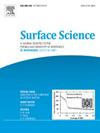First-principles study on the adsorption behavior of ZnO and Mn-doped ZnO with CO and NH3 gases
IF 1.8
4区 化学
Q3 CHEMISTRY, PHYSICAL
引用次数: 0
Abstract
The present work investigates the structural, electronic, and magnetic properties of a (3 × 3 × 1) supercell monolayer of Mn doped ZnO (Mn-ZnO), CO adsorbed on ZnO (CO-ZnO), NH3 adsorbed on ZnO (NH3-ZnO), and CO & NH3 adsorbed on Mn-ZnO (CO-Mn-ZnO, & NH3−Mn-ZnO) structures. Density functional theory (DFT) method with a projected augmented basis set has been used for this study, by employing two different exchange-correlation functionals: GGA-PBE and GGA-PBE+U through the Vienna-Ab-intio Simulation Package (VASP) software. We analyzed the lattice parameters, which reveal that doping Mn into ZnO, and adsorbing NH3 and CO molecules on both ZnO and Mn-ZnO result in changes to the lattice parameters. Thus, the adsorbed molecules alter the lattice parameters, suggesting that both ZnO and Mn-ZnO have the ability to detect poisonous gases. Moreover, we also studied the band gap energy of considered materials using two functionals, PBE and PBE+U. The obtained band gap energies are closer to the experimental values when applying the PBE+U functional. Lastly, pristine ZnO, as well as CO, and NH3 adsorbed ZnO (CO-ZnO, & NH3-ZnO), are found to be non-magnetic, whereas Mn-ZnO, along with CO, and NH3 adsorbed Mn-ZnO (CO-Mn-ZnO, & NH3−Mn-ZnO) are found to be magnetic. Based on electronic and magnetic properties, considered materials are suited for sensing devices.

ZnO和mn掺杂ZnO在CO和NH3气体中吸附行为的第一性原理研究
本文研究了Mn掺杂ZnO (Mn-ZnO)、CO吸附ZnO (CO-ZnO)、NH3吸附ZnO (NH3-ZnO)和CO &;NH3吸附在Mn-ZnO (CO-Mn-ZnO, &;NH3−Mn-ZnO)结构。本研究采用带投影增广基集的密度泛函理论(DFT)方法,通过维也纳- ab -intio仿真包(VASP)软件采用GGA-PBE和GGA-PBE+U两种不同的交换相关泛函。通过对晶格参数的分析,我们发现在ZnO中掺杂Mn,在ZnO和Mn-ZnO上同时吸附NH3和CO分子会导致晶格参数的变化。因此,被吸附的分子改变了晶格参数,表明ZnO和Mn-ZnO都具有检测有毒气体的能力。此外,我们还利用PBE和PBE+U两种功能函数研究了所考虑材料的带隙能。应用PBE+U泛函得到的带隙能更接近实验值。最后,原始ZnO、CO和NH3吸附ZnO (CO-ZnO, &;NH3- zno)是无磁性的,而Mn-ZnO与CO和NH3一起吸附Mn-ZnO (CO-Mn-ZnO, &;NH3−Mn-ZnO)是磁性的。基于电子和磁性,所考虑的材料适用于传感设备。
本文章由计算机程序翻译,如有差异,请以英文原文为准。
求助全文
约1分钟内获得全文
求助全文
来源期刊

Surface Science
化学-物理:凝聚态物理
CiteScore
3.30
自引率
5.30%
发文量
137
审稿时长
25 days
期刊介绍:
Surface Science is devoted to elucidating the fundamental aspects of chemistry and physics occurring at a wide range of surfaces and interfaces and to disseminating this knowledge fast. The journal welcomes a broad spectrum of topics, including but not limited to:
• model systems (e.g. in Ultra High Vacuum) under well-controlled reactive conditions
• nanoscale science and engineering, including manipulation of matter at the atomic/molecular scale and assembly phenomena
• reactivity of surfaces as related to various applied areas including heterogeneous catalysis, chemistry at electrified interfaces, and semiconductors functionalization
• phenomena at interfaces relevant to energy storage and conversion, and fuels production and utilization
• surface reactivity for environmental protection and pollution remediation
• interactions at surfaces of soft matter, including polymers and biomaterials.
Both experimental and theoretical work, including modeling, is within the scope of the journal. Work published in Surface Science reaches a wide readership, from chemistry and physics to biology and materials science and engineering, providing an excellent forum for cross-fertilization of ideas and broad dissemination of scientific discoveries.
 求助内容:
求助内容: 应助结果提醒方式:
应助结果提醒方式:


